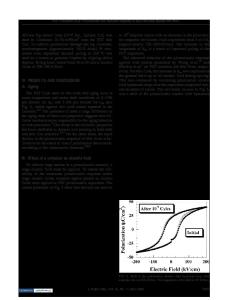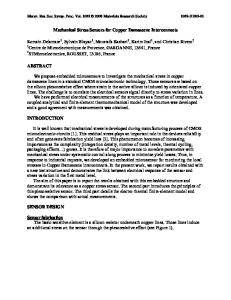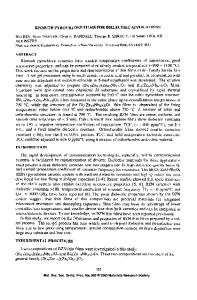Reliability of Dielectric Barrier Films in Copper Damascene Applications
- PDF / 264,120 Bytes
- 6 Pages / 612 x 792 pts (letter) Page_size
- 72 Downloads / 359 Views
F5.10.1
Reliability of Dielectric Barrier Films in Copper Damascene Applications Albert S. Lee, Annamalai Lakshmanan, Nagarajan Rajagopalan, Zhenjiang Cui, Maggie Le, Li Qun Xia, Bok Heon Kim, and Hichem M’Saad Dielectric Systems & Modules Product Business Group Applied Materials Inc., Santa Clara, CA 95054, U.S. A. ABSTRACT The film properties of two PECVD deposited dielectric copper barrier films have been optimized to improve BEOL device reliability in terms of electromigration. Two critical aspects that affect electromigration are the dielectric barrier film hermeticity and adhesion to copper. We use a method to quantify the barrier film hermeticity and have optimized the hermeticity of the BLOκ™ low-κ dielectric barrier film to be similar to that of silicon nitride. By using FT-IR we find that the film porosity has a much stronger effect than the film stoichiometry on hermeticity. In addition, the interfaces between Damascene Nitride™ with copper, as well as BLOκ with copper have been engineered to improve the interfacial adhesion energy to >10 J/m2 for both Damascene Nitride and BLOκ. INTRODUCTION With the advent of copper dual damascene, dielectric copper barriers are becoming the cornerstone for back end of line device reliability. This paper will address two concepts for dielectric thin film reliability: hermeticity of the bulk barrier film and adhesion between the barrier and copper layers. It is known that the interface between copper and the dielectric barrier is the fastest diffusion path for copper electromigration, and that improved adhesion of the barrier film to copper reduces copper electromigration [1,2]. In this paper, we show that adhesion is improved by interfacial engineering of the barrier film. We introduce the concept of hermeticity, which is the film’s ability to prevent moisture from penetrating into the underlying layer. As we transition to lower-κ barriers, the barrier film density decreases and porosity increases. Hence, the ability of the barrier to stop impurities or moisture from reaching the underlying copper becomes a challenge. A non-hermetic film can allow copper oxide formation at the barrier-copper interface, leading to adhesion loss and poor electromigration performance. Thus, the hermeticity of the dielectric barrier becomes an important criterion for barrier integrity. In this work we have optimized the hermeticity of BLOκ [3] low-κ copper barrier film. In addition, we have examined methods to modify the interface between copper and barrier films in such a way as to dramatically improve the adhesion of the BLOκ and Damascene Nitride SixNy [4,5] films to copper. EXPERIMENTAL DETAILS We deposited both BLOκ and Damascene Nitride in a PECVD Producer SE Twin Chamber. Films were deposited on 300mm substrates. The processing temperature was
F5.10.2
350°C to 400oC, and gas pressures ranging from 2-8 Torr were maintained in the chamber during deposition. RF powers ranging from 300-1500W were used to deposit the film. Damascene Nitride was deposited using silane (SiH4) as the
Data Loading...









